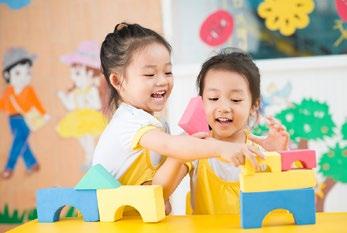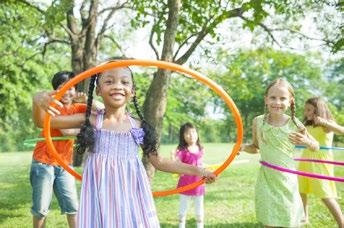
6 minute read
CHILDREN’S PLAY: BACK TO THE BASICS
DR DIKSHA LUNGANI
Let’s go on a journey to explore the ‘what, why and how’ of one of the most underrated aspects of child development: play. Not play-based learning or video games, just, play. Call it free, unstructured, child-driven or child-led play, they are all the same - free time centred around the child’s interests. Not led by an adult or goal-directed, which then becomes a chore or a learning opportunity. Our role is simply to provide the space, time and opportunity for play, not to control it.
Advertisement
Here is my take on why we need to preserve or bring back this precious jewel – for them and us.
So why bother with play?
The benefits of play for a child’s socialemotional, physical and cognitive development are immeasurable. Play is a natural antidote to rising concerns about obesity and the lack of physical activities and increasing mental health needs in the younger generations.
The United Nations Convention on the Rights of the Child classifies play as a fundamental human right, a position endorsed by the British Psychological Society . The latter cautioned against diminishing playtimes at school and also advised against losing playtime as a threat/punishment/consequence or simply instead of completing schoolwork. Playtime at school provides an incredible opportunity for promoting learning readiness through better regulation of attention, memory, emotions and senses, and acts as a transition buffer or refuge for vulnerable pupils.
Social-emotional wellbeing
Free play provides a window into a child’s inner world. To an adult, engaging in play with a child is an opportunity to form lasting bonds, at school or home. Processes of conflictresolution, negotiation, sharing and turn-taking while playing with others promote social skill development.
Regarding social play, it is relevant to quickly mention here that children typically undergo stages in their participation during play, from 0-5 years of age. Mildred Parten , an American sociologist and researcher, highlighted the most commonly known stages: Unoccupied (lacking purpose), Solitary (independent), Onlooker (some interest but no participation with others), Parallel (playing alongside others), Associative (some interaction and sharing but no common play goal) and Cooperative (organised play with set rules and roles for all) play.
*Please do not use these as a checklist, but as points of interest during playful observations of a child.
Coping with the frustrations of losing a game or not being chosen for one, and overcoming obstacles foster emotional regulation. Play also forms the basis for a therapeutic intervention, i.e. play therapy, in which children are provided with a space to work through some difficult life experiences. All these aspects related to attachment, social and emotional health are key to developing resilience in children: the ability to adapt and bounce back from adversities.
Regarding the self-development, play is an outlet for children’s brimming curiosity and creativity; it promotes self-esteem, confidence, independence and identity formation through mechanisms of control, choice-making and having the power to manipulate play. A sense of community and cultural identity can also be fostered through play – of additional importance for expatriate families living away from their countries, a common feature in the Middle East.
Physical & cognitive development
Engaging in play releases all four of the happy hormones in the brain: serotonin, dopamine, endorphins and oxytocin - all of which, some adults are struggling to manufacture nowadays! Play aids in forming neural pathways within the pre-frontal cortex, which is like the brain’s air traffic control centre - performing high-level executive functions such as decision-making, problem-solving and self-regulation. Early play experiences also provide the foundation for later learning to take place, such as cause & effect, sorting, grouping, etc. Through play’s
sensory and tactile nature, children rapidly develop fine and gross motor skills, for instance, through roughand-tumble, using playdough or other active endeavours.

However, there is often a misconception that children’s brain development maxes out around five years of age, due to which the importance of play supposedly diminishes afterward - this needs to be corrected. The science of neuroplasticity, i.e. ability of the brain to form connections throughout life, especially during adolescence reinforces the importance of having time to indulge in unstructured activities well into school age and beyond. Creativity and innovation were never borne out of a 45-minute set time slot!
The importance of being bored
This brings us to another important aspect: boredom! In our quest to be more efficient and successful members of society, we have portrayed our organisational skills onto children’s schedules, action-packing them to the brim with learning opportunities and extra-curricular activities which are designed to provide constant stimulation to the brain. Not doing so, we feel, is a reflection on our abilities as parents/educators – the reality couldn’t be far from it! Unfortunately, such beliefs have taken away precious time from play and its enormous benefits. They have contributed to a growing culture of digital addiction amongst many teens and adults who cannot stay unoccupied or in solitude for even 10 minutes.
Think of the immense life lessons that children learn by having idle-time or doodling:
5 Processing the day’s events, tuning into themselves, forming new ideas or simply daydreaming; 5 Perseverance, initiative-taking and problem-solving (even if it’s the simple one of how to stop being bored); 5 Being present in the moment; 5 That life is not a circus with different acts scheduled to amuse or entertain them all the time; 5 And finally, for us, letting go of the intense guilt which washes over our beings when we see a child looking bored. The right formula for play
In my experience, there are often concerns about the ‘right’ kind or a certain ‘number’ of toys. There is no magic formula, just to keep away from extremes and provide developmentally appropriate objects. Some professionals recommend a ‘less is more’ approach to toys, as it promotes minimalism, provides opportunities to maintain sustained attention and facilitates creativity.
My recommendation would be to provide a range of open-ended materials (which could be used in different ways – this is the key) and to focus on the time available for free play, which should not be any lesser than 60 minutes a day for school-aged children, if not more. Outdoor play in the Middle East is tricky to plan, so make best use of the evenings and weekends.
A very basic play kit could contain materials (if age-appropriate) such as: art, stationery, make-believe toys such as figurines (dolls/puppets), household items, sensory or messy stuff such as slime/clay/sand/water, board games, blocks, a ball, old clothes to play dress up, or about anything else that catches their fancy! You could even include culture-specific materials – for instance, as a child, I enjoyed dressing up with fancy ethnic scarves and playing cricket. Also include both gender-neutral (e.g. toy telephones, ride-on toys, puzzles) and genderspecific (e.g. dolls, action figures) toys, as they aid in developing identities and tolerance.
So, go on, invite the neighbours’, colleagues’, friends’ kids over to play with yours as long as it is safe to do so; join them if you can. When at school, let pupils play how and with whom they want to. Share stories of what you liked to play with when you were a child. Encourage children to enrol in activities based on interests emerging from their play, not the other way around. In other words, go back to the basics!
Dr Diksha Laungani is a UK-qualified and DHCC-licensed Educational Psychologist and Training Specialist. Her doctoral thesis explored the views of young adults with learning difficulties and their families during their transition to supported employment. Diksha’s professional interests include promoting the independence of people with SEND/determination and facilitating disability awareness in the community. She is also interested in supporting educators’ professional development through training and supervision. As a practitioner, Diksha characterises herself as a person-centred and humanistic psychologist and is a firm proponent of embracing solution-focused approaches in education.










